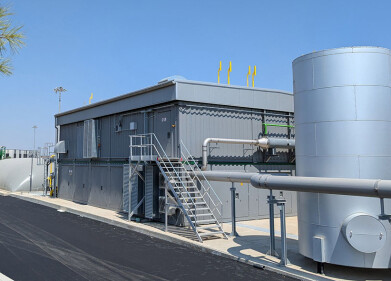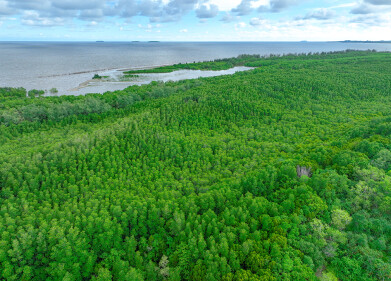-
 Picture 2: Dürr air pollution control systems for sustainable PTA production in China
Picture 2: Dürr air pollution control systems for sustainable PTA production in China -
 Picture 1: One of the world's largest RTO installations with 2.31 Mio. Nm3/h treatment capacity
Picture 1: One of the world's largest RTO installations with 2.31 Mio. Nm3/h treatment capacity
Air clean up
Regenerative thermal oxidizer air pollution control systems for Yisheng Petrochemical
Mar 03 2022
The chemical group Yisheng Petrochemical Co., Ltd. has relied on air purification technologies from Dürr since 2010. The most recent investment in Eastern China Ningbo/Zhenhai includes seven regenerative thermal oxidizer (RTO) air pollution control systems. They ensure reliable, energy-saving, and CO2-reduced purification of the exhaust air streams on a large scale. This results in one of the 's's most significant RTO installations with a 2.31 Mio. Nm3/h treatment capacity. For Dürr, the project is one of the largest of its kind to date.
At its site in Ningbo in the Eastern Chinese province of Zhejiang, the chemical group Yisheng Petrochemical Co., Ltd. mainly produces purified terephthalic acid (PTA). PTA is in demand as a starting material for critical polymers to produce plastic bottles, textiles and food packaging. Yisheng Petrochemical is one of the world's largest PTA manufacturers and production capacities in Ningbo are correspondingly high. Two of the chemical giant's seven production lines have an output of three million tons of PTA per year. A particular challenge in producing the colorless powder is treating the partially polluted exhaust air streams. Dürr was entrusted to install its Oxi.X RE systems. The RTO systems remove the harmful components from the exhaust air generated during PTA production. This ensures that no polluted exhaust gases escape into the atmosphere.
Technical excellence for highly effective air pollution control
Dürr supplied seven identical turnkey Oxi.X RE systems for the regenerative thermal oxidation process and a corresponding number of Sorpt.X SW wet scrubbers to Yisheng Petrochemical. Each system consists of a nine-tower Oxi.X RE, a down-stream scrubber and a clean gas stack. The treatment capacity of a nine-tower RTO is about 330.000 Nm3/h, making it one of the world's most extensive RTO installations with 2.31 Mio. Nm3/h treatment capacity for the seven units.
The exhaust air contaminated with pollutants first passes through a regenerative ceramic heat exchanger. This heats the exhaust air, which is very close to the reaction temperature before reaching the combustion chamber. All pollutants are converted into harmless components in the RTO combustion chamber by exposing them to the optimum combustion temperature. The now purified gases pass through a ceramic heat exchanger, releasing their heat to the ceramic media. This stage completes the regenerative cycle.
After the complete oxidation of the volatile organic compounds (VOC) in the RTO units, an acid scrubber removes bromine and other halogenated compounds from the flue gas. Clean air is emitted to the atmosphere at the height of 60 meters through the stack, which is installed on top of the scrubber.
Economical and energy efficient despite large dimensions
Within a few months, four of the RTO units installed at Yisheng Petrochemical were put into operation and have been operating since July 2021. Three additional units were also put into operation in January 2022. A total of 1,340 tons of stainless and carbon steel are used for the RTOs and their ductwork, as well as more than 200 poppet valves, over 220,000 pieces of ceramic media, and over 150 kilometers of cable. For Dürr, the project is one of the largest of its kind to date.
All regenerative thermal oxidizer systems made by Dürr achieve a destruction and removal efficiency (DRE) of nearly 100%. This is necessary to meet the stringent emission standards in China and elsewhere. Economical and eco-friendly, Dürr's RTO systems have low maintenance requirements due to sealing-free, horizontally arranged poppet valves and easy inspection access.
Energetically optimized oxidizers from Dürr operate without additional fuel. Fossil fuel is only needed for the heating-up mode. Self-sustaining with the energy input from the exhaust air, the RTO units reduce the client's carbon footprint by operating in auto-thermal mode.
Events
May 18 2025 Algiers, Algeria
23rd International Water Management Exhibition
May 20 2025 Prague, Czech Republic
Jun 17 2025 Guangzhou, China
Singapore International Water Week Spotlight 2025
Jun 23 2025 Singapore
Jun 25 2025 Sao Paulo, Brasil















